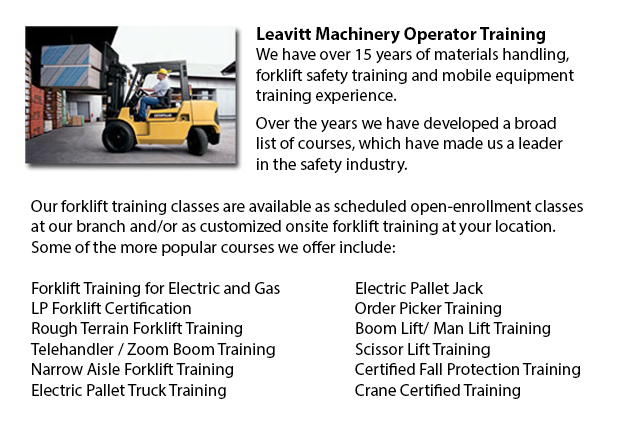
Rough Terrain Forklifts Training Burlington - There are essentially two classifications of lift trucks within the production industry, the rough terrain model and the industrial version. Rough terrain forklifts appeared in the 1940's built predominantly for use on rough roads, best for lumberyards and construction sites, providing lifting muscle when there was no paved surface existing.
Rough ground lift trucks usually utilize an internal combustion engine with a battery for power. The engines are able to function on propane, diesel or gasoline. Many manufacturers are playing with rough land lift trucks that make use of vegetable matter and run from ethanol. Huge pneumatic tires with deep treads typify these lift trucks to permit them to grab onto the roughest ground type devoid of any misstep or drifting.
Many of the original versions of rough terrain lift trucks had the ability to haul in excess of 1000 lbs, using forks that could slide underneath the item, jack it slightly and shift it to another site. After ten years on the market, rough terrain forklifts were reinforced with supplementary hauling muscle, increasing the possible load to more than 2000 lbs. Telescoping booms were added in the 1960's, allowing them to stack resources a good deal higher than in earlier years. The telescoping model characteristic is a staple of most all terrain forklifts at the moment. Present versions are capable of managing well over 4000 lbs thanks to the continual enhancements over the years. Telescoping capability has also improved with some designs reaching a height of 35 feet. Operator safety has also become a focus with many rough terrain lift trucks now manufactured are equipped with an enclosed cab for the operator, as opposed to the older open air seating capacity.
The rough terrain forklifts offered these days work equally as well on paved floors as on unpaved surfaces. These rough terrain lift trucks are being marketed for their usefulness allowing firms to transport parts from outside the facility to the inside or vice versa.
-
Genie Forklift
Genie Forklift Training Burlington - Genie is a globally recognized corporation that enjoys the spirit of partnership with their extensive network of associated clients. Genie Industries prides itself on the intention of bringing materials and people... More -
Pallet Lifts
Pallet Lifts Training Burlington - A pallet jack is a device built especially for moving pallets of varying weights and sizes. They can be utilized in conjunction with cranes, forklifts and other heavy duty machinery as an accessory piece or to be em... More -
Pallet Stackers
Pallet Stackers Training Burlington - A pallet stacker is a kind of pallet jack that is utilized to move, stack and lift palletized cargo that are too difficult for manual lifting. Its key function is to load and unload pallets on vehicles, as well a... More -
Komatsu Forklift
Komatsu Forklift Training Burlington - Komatsu Forklift U.S.A. Inc. has a very good reputation for building dependable and robust forklifts. Komatsu is recognized around the globe as a business with a prosperous heritage while retaining an admirable... More -
Reach Trucks
Reach Truck Training Burlington - Reach trucks are loading devices used by varieties of companies that maintain a storeroom facility or distribution center concerning the organization of finished merchandise and supplies on pallets which are inserted... More

Forklift Training Burlington
TOLL FREE: 1-888-254-6157
Burlington, Ontario
forklifttrainingburlington.com
Email Us
About Us


